Questões de Vestibular FAMEMA 2017 para Vestibular 2018 - Prova II
Foram encontradas 40 questões
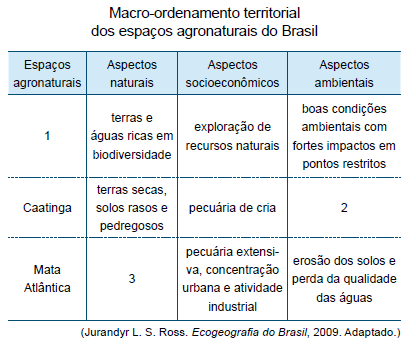
Analisando a tabela e considerando conhecimentos acerca
do meio ambiente no território brasileiro, pode-se afirmar que
os números 1, 2 e 3 correspondem, respectivamente,
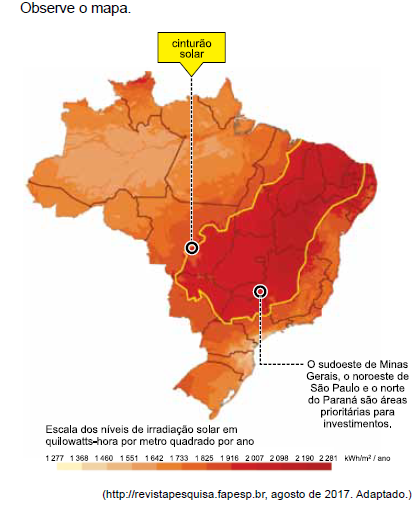
O Atlas Brasileiro de Energia Solar recomenda investimentos
em novas plantas de geração de energia solar no sudoeste
de Minas Gerais, no noroeste de São Paulo e no norte do
Paraná, embora elevados níveis de irradiação sejam encontrados no Nordeste do país. Essa aparente contradição é refutada por haver
Para determinar __________ no mar, basta sair do porto com um relógio que não se desacerte e, ao meio-dia local, determinar a hora no porto de partida. Com a ajuda das tábuas de navegar que têm as horas do meio-dia no porto de partida, para todos os dias do ano, os pilotos podem calcular a diferença horária entre o meio-dia solar do ponto em que estão e o do porto de partida. Por cada hora de diferença horária, estão mais ou menos 15 graus para leste ou oeste em relação ao porto de partida.
(www.cienciaviva.pt. Adaptado.)
Assinale a alternativa que preenche corretamente a lacuna
do texto.
Ibn al-Khatib, médico e filósofo muçulmano de Granada, escreveu sobre a Peste Negra no século XIV: “A existência do contágio é estabelecida pela experiência, investigação, evidência dos sentidos e relatos dignos de fé. O fenômeno do contágio torna-se claro para o investigador que verifica como aquele que entra em contato com os enfermos apanha a doença, enquanto o que não está em contato permanece são, e como a transmissão se efetua através do vestuário, vasilhame e atavios.”
(Maria Guadalupe Pedrero-Sánchez. A Península Ibérica entre o Oriente e o Ocidente, 2002. Adaptado.)
Esse comentário sobre a epidemia revela
Havia muito capital e muita riqueza entre os lavradores de cana, alguns ligados por laços de sangue ou matrimônio aos senhores de engenho. Havia também um bom número de mulheres, não raro viúvas, participando da economia açucareira. Digno de nota até o fim do século XVIII, contudo, era o fato de os lavradores de cana serem quase invariavelmente brancos. Os negros e mulatos livres simplesmente não dispunham de créditos ou capital para assumir os encargos desse tipo de agricultura.
(Stuart Schwartz. “O Nordeste açucareiro no Brasil Colonial”. In: João Luis R. Fragoso e Maria de Fátima Gouvêa (orgs). O Brasil Colonial, vol 2, 2014.)
O excerto indica que a sociedade colonial açucareira foi
No século XIX, o movimento mais amplo é a Revolução Industrial, cuja força-motora é a Grã-Bretanha, que passa a ocupar, sem o menor esforço, o lugar da Espanha e de Portugal na América do Sul, tanto para escoar seus produtos industriais como para controlar os circuitos comerciais. Os novos Estados endividam-se para comprar as maravilhas da indústria inglesa e os ingleses contentam-se em fazer negócios. Em Cuba, as companhias norte-americanas apropriam- -se das terras açucareiras. Pouco depois, as planícies da América Central são atacadas: está nascendo o império bananeiro, controlado por Boston.
(Marc Ferro. Histórias das colonizações, 1996. Adaptado.)
O excerto alude
Observe a charge sobre o Tratado de Versalhes.
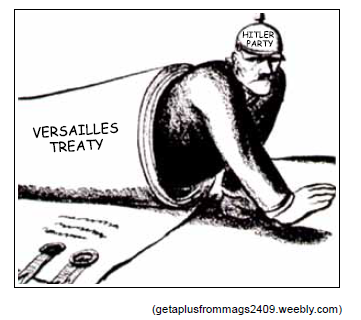
A charge estabelece uma relação entre
A tragédia dos últimos meses do governo Goulart residiu na tendência cada vez mais acentuada de se descartar a via democrática para a solução da crise. A direita ganhou os conservadores moderados, sobretudo amplos setores da classe média, para sua perspectiva de que só uma revolução promoveria a “purificação da democracia”, pondo fim aos perigos do comunismo, à luta de classes, ao poder dos sindicatos e à corrupção. Na esquerda, a então chamada democracia formal era vista apenas como um instrumento que ia se tornando inútil, ao aproximar-se a tomada do poder.
(Boris Fausto. “A vida política”. In: Angela de Castro Gomes (org). Olhando para dentro: 1930-1964, vol 4, 2013. Adaptado.)
Essa interpretação do historiador sobre o final do governo de
João Goulart (1961-1964) remete
Drinking coffee could help you live longer Coffee not only helps you feel full of beans, it might add years to your life as well, two major studies have shown. Scientists in Europe and the US have uncovered the clearest evidence yet that drinking coffee reduces the risk of death.
One study of more than half a million people from 10 European countries found that men who downed at least three cups of coffee a day were 18% less likely to die from any cause than non-coffee drinkers. Women drinking the same amount benefited less, but still experienced an 8% reduction in mortality over the period measured.
Similar results were reported by American scientists who conducted a separate investigation, recruiting 185855 participants from different ethnic backgrounds. Irrespective of ethnicity, people who drank two to three cups of coffee daily had an 18% reduced risk of death.
Each of the studies, both published in the journal Annals of Internal Medicine, showed no advantage from drinking either caffeinated or decaffeinated coffee. Experts believe the antioxidant plant compounds in coffee rather than caffeine are responsible for the life-extending effect. Previous research has suggested that drinking coffee can reduce the risk of heart disease, diabetes, liver disease, and some cancers.
Dr Marc Gunter, from the International Agency for Research on Cancer, who led the European study with colleagues from Imperial College London, said: “We found that higher coffee consumption was associated with a lower risk of death from any cause and specifically for circulatory diseases and digestive diseases. Importantly, these results were similar across all of the 10 European countries, with variable coffee drinking habits and customs. Our study also offers important insights into the possible mechanisms for the beneficial health effects of coffee.”
(www.huffingtonpost.co.uk, 11.07.2017. Adaptado.)
Drinking coffee could help you live longer Coffee not only helps you feel full of beans, it might add years to your life as well, two major studies have shown. Scientists in Europe and the US have uncovered the clearest evidence yet that drinking coffee reduces the risk of death.
One study of more than half a million people from 10 European countries found that men who downed at least three cups of coffee a day were 18% less likely to die from any cause than non-coffee drinkers. Women drinking the same amount benefited less, but still experienced an 8% reduction in mortality over the period measured.
Similar results were reported by American scientists who conducted a separate investigation, recruiting 185855 participants from different ethnic backgrounds. Irrespective of ethnicity, people who drank two to three cups of coffee daily had an 18% reduced risk of death.
Each of the studies, both published in the journal Annals of Internal Medicine, showed no advantage from drinking either caffeinated or decaffeinated coffee. Experts believe the antioxidant plant compounds in coffee rather than caffeine are responsible for the life-extending effect. Previous research has suggested that drinking coffee can reduce the risk of heart disease, diabetes, liver disease, and some cancers.
Dr Marc Gunter, from the International Agency for Research on Cancer, who led the European study with colleagues from Imperial College London, said: “We found that higher coffee consumption was associated with a lower risk of death from any cause and specifically for circulatory diseases and digestive diseases. Importantly, these results were similar across all of the 10 European countries, with variable coffee drinking habits and customs. Our study also offers important insights into the possible mechanisms for the beneficial health effects of coffee.”
(www.huffingtonpost.co.uk, 11.07.2017. Adaptado.)
Drinking coffee could help you live longer Coffee not only helps you feel full of beans, it might add years to your life as well, two major studies have shown. Scientists in Europe and the US have uncovered the clearest evidence yet that drinking coffee reduces the risk of death.
One study of more than half a million people from 10 European countries found that men who downed at least three cups of coffee a day were 18% less likely to die from any cause than non-coffee drinkers. Women drinking the same amount benefited less, but still experienced an 8% reduction in mortality over the period measured.
Similar results were reported by American scientists who conducted a separate investigation, recruiting 185855 participants from different ethnic backgrounds. Irrespective of ethnicity, people who drank two to three cups of coffee daily had an 18% reduced risk of death.
Each of the studies, both published in the journal Annals of Internal Medicine, showed no advantage from drinking either caffeinated or decaffeinated coffee. Experts believe the antioxidant plant compounds in coffee rather than caffeine are responsible for the life-extending effect. Previous research has suggested that drinking coffee can reduce the risk of heart disease, diabetes, liver disease, and some cancers.
Dr Marc Gunter, from the International Agency for Research on Cancer, who led the European study with colleagues from Imperial College London, said: “We found that higher coffee consumption was associated with a lower risk of death from any cause and specifically for circulatory diseases and digestive diseases. Importantly, these results were similar across all of the 10 European countries, with variable coffee drinking habits and customs. Our study also offers important insights into the possible mechanisms for the beneficial health effects of coffee.”
(www.huffingtonpost.co.uk, 11.07.2017. Adaptado.)
Drinking coffee could help you live longer Coffee not only helps you feel full of beans, it might add years to your life as well, two major studies have shown. Scientists in Europe and the US have uncovered the clearest evidence yet that drinking coffee reduces the risk of death.
One study of more than half a million people from 10 European countries found that men who downed at least three cups of coffee a day were 18% less likely to die from any cause than non-coffee drinkers. Women drinking the same amount benefited less, but still experienced an 8% reduction in mortality over the period measured.
Similar results were reported by American scientists who conducted a separate investigation, recruiting 185855 participants from different ethnic backgrounds. Irrespective of ethnicity, people who drank two to three cups of coffee daily had an 18% reduced risk of death.
Each of the studies, both published in the journal Annals of Internal Medicine, showed no advantage from drinking either caffeinated or decaffeinated coffee. Experts believe the antioxidant plant compounds in coffee rather than caffeine are responsible for the life-extending effect. Previous research has suggested that drinking coffee can reduce the risk of heart disease, diabetes, liver disease, and some cancers.
Dr Marc Gunter, from the International Agency for Research on Cancer, who led the European study with colleagues from Imperial College London, said: “We found that higher coffee consumption was associated with a lower risk of death from any cause and specifically for circulatory diseases and digestive diseases. Importantly, these results were similar across all of the 10 European countries, with variable coffee drinking habits and customs. Our study also offers important insights into the possible mechanisms for the beneficial health effects of coffee.”
(www.huffingtonpost.co.uk, 11.07.2017. Adaptado.)
Drinking coffee could help you live longer Coffee not only helps you feel full of beans, it might add years to your life as well, two major studies have shown. Scientists in Europe and the US have uncovered the clearest evidence yet that drinking coffee reduces the risk of death.
One study of more than half a million people from 10 European countries found that men who downed at least three cups of coffee a day were 18% less likely to die from any cause than non-coffee drinkers. Women drinking the same amount benefited less, but still experienced an 8% reduction in mortality over the period measured.
Similar results were reported by American scientists who conducted a separate investigation, recruiting 185855 participants from different ethnic backgrounds. Irrespective of ethnicity, people who drank two to three cups of coffee daily had an 18% reduced risk of death.
Each of the studies, both published in the journal Annals of Internal Medicine, showed no advantage from drinking either caffeinated or decaffeinated coffee. Experts believe the antioxidant plant compounds in coffee rather than caffeine are responsible for the life-extending effect. Previous research has suggested that drinking coffee can reduce the risk of heart disease, diabetes, liver disease, and some cancers.
Dr Marc Gunter, from the International Agency for Research on Cancer, who led the European study with colleagues from Imperial College London, said: “We found that higher coffee consumption was associated with a lower risk of death from any cause and specifically for circulatory diseases and digestive diseases. Importantly, these results were similar across all of the 10 European countries, with variable coffee drinking habits and customs. Our study also offers important insights into the possible mechanisms for the beneficial health effects of coffee.”
(www.huffingtonpost.co.uk, 11.07.2017. Adaptado.)
A figura representa um satélite geoestacionário em movimento circular e uniforme a uma distância (d) da superfície da Terra. A trajetória desse satélite está contida no plano equatorial terrestre e seu período de translação é igual ao de rotação da Terra, cerca de 24h.
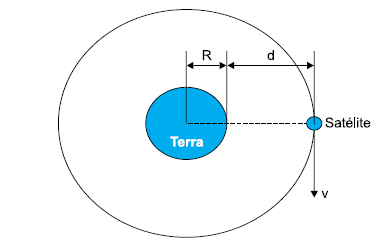
Considerando que o raio equatorial da Terra mede R e adotando π = 3, a velocidade orbital desse satélite é de
Um raio de luz monocromático propaga-se por um meio A,que apresenta índice de refração absoluto nA = 1, e passapara outro meio B, de índice de refração nB = √2, conforme a figura
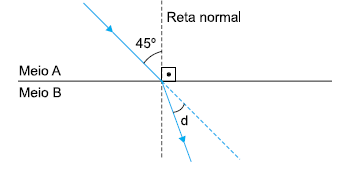
Considere que o raio incidente forma com a normal à
superfície o ângulo de 45º. Nessas condições, o ângulo de
desvio (d), indicado na figura, é igual a
A figura representa um instrumento musical de sopro constituído por um tubo de comprimento L, aberto nas duas extremidades. Ao soprar esse instrumento, estimula-se a vibração do ar, produzindo ondas estacionárias, que se propagam com velocidade (v), dentro desse tubo, conforme a figura.
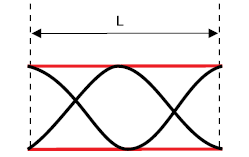
Considerando essas informações, a frequência do som emitido por esse instrumento será
Raios cósmicos constantemente arrancam elétrons das moléculas do ar da atmosfera terrestre. Esses elétrons se movimentam livremente, ficando sujeitos às forças eletrostáticas associadas ao campo elétrico existente na região que envolve a Terra. Considere que, em determinada região da atmosfera, atue um campo elétrico uniforme de intensidade E = 100 N/C, conforme representado na figura.
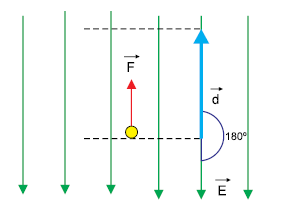
Se um elétron de carga 1,6 × 10–19 C e de massa desprezível,
sujeito a uma força constante, se movimenta verticalmente
para cima nessa região, percorrendo uma distância d = 500 m,
a variação de energia potencial elétrica sofrida por ele, nesse
trajeto, será de
A tabela apresenta parte das informações contidas em uma conta de energia elétrica de determinada residência.

Considere que, nessa residência, 8 lâmpadas de 60 W fiquem
acessas durante 4 horas por dia, durante um mês de 30 dias.
O valor a ser pago por esse consumo será de